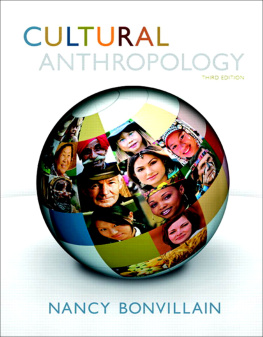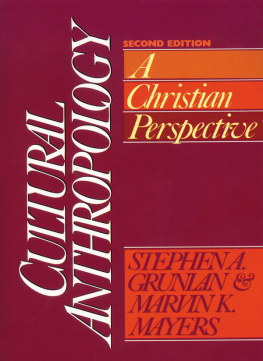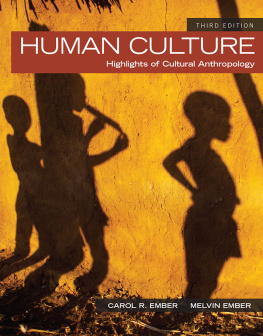
Why Do You Need this New Edition?
If youre wondering why you should buy this new edition of Cultural Anthropology, here are 6 good reasons!
New section on Language and Globalization in .
New section on White Privilege in .
Expanded discussion in covering warfare and state societies, including current issues in the Middle East.
Expanded discussions of the revitalization movements and the role of Moses as a religious leader in .
New section in on World Systems Theory.
Several new sections in , including: Indians of the Brazilian Savanna; Uncontacted Tribes of the Amazon; Conservation, Ecotourism, and Indigenous Peoples; and Climate Change and Indigenous Peoples.

Cultural Anthropology
Third Edition
Nancy Bonvillain
Bard College at Simons Rock

Boston Columbus Indianapolis New York San Francisco Upper Saddle River Amsterdam Cape Town Dubai London Madrid Milan Munich Paris Montral Toronto Delhi Mexico City Sao Paulo Sydney Hong Kong Seoul Singapore Taipei Tokyo

At Pearson Education were committed to producing books in an earth-friendly manner and to helping our customers make greener choices.
Manufacturing books in the United States ensures compliance with strict environmental laws and eliminates the need for international freight shipping, a major contributor to global air pollution.
Printing on recycled paper helps minimize our consumption of trees, water and fossil fuels. The text of Cultural Anthropology, Third Edition, was printed on paper made with 10% post-consumer waste, and the cover was printed on paper made with 10% post-consumer waste. According to Environmental Paper Network Calculator, by using this innovative paper instead of conventional papers, we achieved the following environmental benefits:
Trees Saved: 22 Greenhouse Gases Eliminated: 3,798 pounds
Water Saved: 9,034 gallons Solid Waste Eliminated: 993 pounds
For more information on our environmental practices, please visit us online at www.pearsonhighered.com /difference
Editorial Director: Craig Campanella
Editor in Chief: Dickson Musslewhite
Publisher: Nancy Roberts
Editorial Project Manager: Nicole Conforti
Editorial Assistant: Nart Varoqua
Director of Marketing: Brandy Dawson
Senior Marketing Manager: Laura Lee Manley
Marketing Assistant: Paige Petunas
Managing Editor: Ann Marie McCarthy
Project Manager: Carol ORourke
Senior Operations Specialist: Alan Fischer
Design Manager: John Christiana
Art Director: Anne Bonanno Nieglos
Interior and Cover Designer: PremediaGlobal
Cover Art: Row 1: (left) LOOK Die Bildagentur der Fotografen
GmbH/Alamy, (right) Stock Connection Blue/Alamy; Row
2: (left) David Davis Photoproductions/Alamy, (center left)
Urikiri-Shashin-Kan/Alamy, (center right) Blaine Harrington
III/Alamy, (right) Monika Gniot/Alamy; Row3: (center right)
Asia Images Group Pte Ltd/Alamy, (center) Ted Wood/Getty
Images, (left) Stephen Dorey/ABIPP/Alamy, (right) Jon
Arnold Images Ltd/Alamy; Row 4: (center) STOCKFOLIO/
Alamy, (left) David Price/Alamy, (right) Rosanne Tackaberry/
Alamy; Row 5: Jack Young - People/Alamy; Row 6: (left) Natali
Glado/Shutterstock, (right) barbaradudzinska/Shutterstock
Digitial Media Editor: Rachel Comerford
Media Project Manager: Barbara Taylor-Laino
Full-Service Project Management: Claire Stanton
Composition: PremediaGlobal
Printer/Binder and Cover Printer: Courier Companies, Inc.

DK Maps designed and productioned by DK Education, a division of Dorling Kindersley Limited, 80 Strand, London WC2R ORL. DK and the DK logo are registered trademarks of Dorling Kindersley Limited.
This book was set in 10/11.5, New Baskerville.
Credits and acknowledgments borrowed from other sources and reproduced, with permission, in this textbook appear on appropriate page within text (or on page ).
Copyright 2013, 2010, 2006 Pearson Education, Inc., publishing as Pearson Education, One Lake St., Upper Saddle River, NJ 07458. All rights reserved. Manufactured in the United States of America. This publication is protected by Copyright, and permission should be obtained from the publisher prior to any prohibited reproduction, storage in a retrieval system, or transmission in any form or by any means, electronic, mechanical, photocopying, recording, or likewise. To obtain permission(s) to use material from this work, please submit a written request to Pearson Higher Education, Rights and Contracts Department, One Lake St., Upper Saddle River, NJ 07458 or fax your request to 617-671-3447.
Obtain the control number from CIP contact .
Library of Congress Control Number:
xxxxxxxxxx
10 9 8 7 6 5 4 3 2 1
Student Edition
ISBN 10: 0-205-86036-2
ISBN 13: 978-0-205-86036-4
Instructors Review Copy
ISBN 10: 0-205-86040-0
ISBN 13: 978-0-205-86040-1
la Carte Edition
ISBN 10: 0-205-86050-8
ISBN 13: 978-0-205-86050-0

Brief Contents
Contents
Special Features
Case Study
Culture Change
Controversies
In Their Own Voices
Anthropology Applied
Preface
Cultural Anthropology, Third Edition, is intended to introduce students to the concepts and methods that anthropologists bring to the study of cross-cultural diversity. It focuses on understanding how cultural practices and beliefs develop, how they are integrated, and how they change. The goal of this book is consistent with one of the goals of most anthropology teachers, to excite students about the world in which we all live. Although much in peoples behaviors and attitudes differs throughout the world, much also unites us. The book therefore provides a global view of humanitys many facets. It takes a traditional approach in chapter organization, focusing on various aspects of societal organization and expression. It also makes central the role of cultural change, processes of adaptation and transformation that are integral to all societies. In addition to learning about other peoples, anthropology as a discipline and a framework of analysis has the potential to help students appreciate the cultural patterns underlying their own behaviors, beliefs, and attitudes. This book attempts to present the voices of the peoples who anthropologists often study. Through these voices, and through analyses of indigenous and marginalized people today, students may come to understand the global processes that affect us all.
An important feature distinguishing this text is its thorough focus on culture change, derived both from internal processes of adaptation and innovation as well as from external forces through contact with other peoples. The context of contact is critical, of course. In some cases, contact is friendly and benign, each group exchanging ideas, practices, and material goods as equals. In other cases, contact occurs between groups that are unequal in their power and ability to control their own lives and exert control over others. In focusing on change, this text highlights the notion that the societies and cultures that people develop are dynamic systems, adapted to new situations and invigorated by new ideas.
Next page


















